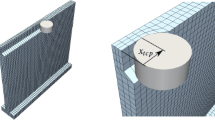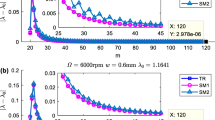Abstract
An efficient approach for milling stability and surface location error (SLE) prediction with varying time delay and cutter runout effect is presented in this paper. Firstly, based on the tooth trochoid motion, the paper proposes a varying time delay model during cutter/workpiece engagement with taking cutter runout into account, establishes a milling dynamic model under arbitrary feed direction, and then derives the state transition matrix in one cutter rotation period by using the Cotes numerical integration formula. The milling stability of the dynamics system are obtained by using Floquet theory. According to the fixed point theory, the displacement response of the dynamic system and the method for solving the SLE are both developed. Later, a series of numerical and experimental works are conducted. The numerical verification shows that the proposed method can achieve a faster convergence rate and higher calculation efficiency than other previous methods. Meanwhile, the prediction of stability and SLE are in good agreement with the experimental results, and have a high accuracy for stability prediction when cutter runout and varying time delay considered. In the end, the numerical studies show that the milling stability and SLE strongly depends on the actual milling conditions, including milling parameters, cutter runout, cutter geometric parameters, and asymmetric structural dynamic parameters, which are helpful for milling process optimization.
Similar content being viewed by others
References
Tlusty J (2000) Manufacturing processes and equipment. Prentice Hall, Upper Saddle River
Altintas Y (2000) Manufacturing automation. Cambridge University Press, New York
Tlusty J, Polacek M (1963) The stability of machine tools against self-excited vibrations in machining. Trans of ASME Int Res in Prod Eng:465–474
Tobias SA (1965) Machine tool vibration. Blackie, London
Tobias SA, Fishwick W (1958) A theory of regenerative chatter. The Engineer, London
Merritt H (1965) Theory of self excited machine tool chatter. Trans ASME J Eng Ind 87(4):447–454
Tlusty J, Ismail F (1981) Basic nonlinearity in machining chatter. Annals CIRP 30:299–304
Tlusty J, Ismail F (1983) Special aspects of chatter in milling. J Vibration, Acoustics. Stress, and Reliability in Design 105: 24–32
Altintas Y, Chan P (1992) In-process detection and suppression of chatter in milling. Int J Mach Tools Manuf 32:329–347
Altintas Y, Budak E (1995) Analytical prediction of stability lobes in milling. Annals CIRP 44(1):357–362
Merdol SD, Altintas Y (2004) Multi frequency solution of chatter stability for low immersion milling. Trans ASME J Manuf Sci Eng 126(3):459–466
Insperger T, Stépán G (2002) Semi-discretization method for delayed systems. Int J Num Meth Eng 55 (5):503–518
Insperger T, Stépán G, Turi J (2008) On the higher-order semi-discretizations for periodic delayed systems. J Sound and Vibration 313(1-2):334–341
Ding Y, Zhu LM, Zhang XJ, Ding H (2010) A full-discretization method for prediction of milling stability. Int J Mach Tools Manuf 50:502–509
Ding Y, Zhu LM, Zhang XJ, Ding H (2010) Second-order full-discretization method for milling stability prediction. Int J Mach Tools Manuf 50(2010):926–932
Quo Q, Sun YW, Jiang Y (2012) On the accurate calculation of milling stability limits using third-order full-discretization method. Int J Mach Tools Manuf 62:61–66
Ding Y, Zhu LM, Zhang XJ, Ding H (2011) Numerical integration method for prediction of milling stability. Trans ASME J Manuf Sci Eng 133(3) 031005
Zhang Z, Li HG, Meng G, Liu C (2015) A novel approach for the prediction of the milling stability based on the Simpson method. Int J Mach Tools Manuf 99:43–47
Martelloti ME (1941) An analysis of the milling process. Transactions of the ASME 63:677–700
Long XH, Balachandran B, Mann BP (2007) Dynamics of milling processes with variable time delays. Nonlinear Dyn 47:49–63
Song QH, Liu ZQ, Shi ZY (2014) Chatter stability for micromilling processes with flat end mill. Int J Adv Manuf Technol 71:1159–1174
Liang XG, Yao ZQ, Luo L, Hu J (2013) An improved numerical integration method for predicting milling stability with varying time delay. Int J Adv Manuf Technol 68:1967– 1976
Seguy S, Insperger T, Arnaud L, Dessein G, Peign G (2010) On the stability of high-speed milling with spindle speed variation. Int J Adv Manuf Technol 48:883–895
Sellmeier V, Denkena B (2011) Stable islands in the stability chart of milling processes due to unequal tooth pitch. Int J Mach Tools Manuf 51(2):152–164
Wan M, Zhang WH, Dang JW, Yang Y (2010) A unied stability prediction method for milling process with multiple delays. Int J Mach Tools Manuf 50:29–41
Montgomery D, Altintas Y (1991) Mechanism of cutting force and surface generation in dynamic milling. Trans ASME J Eng Ind 113:160–168
Altintas Y, Lee P (1996) A general mechanics and dynamics model for helical end mills. Annals CIRP 45 (1):59–64
Altintas Y, Engin S (2001) Generalized modeling of mechanics and dynamics of milling cutters. Annals CIRP 50(1):25–30
Ismail F, Elbestawi MA, Du R, Urbasik K (1993) Generation of milled surfaces including tool dynamics and wear. Trans ASME J Eng Ind 115:245–252
Schmitz TL, Couey J, Marsh E, Mauntler N, Hughes D (2007) Runout effects in milling: surface finish, surface location error, and stability. Int J Mach Tools Manuf 47:841–851
Schmitz TL (2009) Machining dynamics frequency response to improved productivity. Springer
Surmann T, Enk D (2007) Simulation of milling tool vibration trajectories along changing engagement conditions. Int J Mach Tools Manuf 47:1442–1448
Surmann T, Biermann D (2008) The effect of tool vibrations on the flank surface created by peripheral milling. CIRP Annals-Manuf Technol 57(1):375–378
Author information
Authors and Affiliations
Corresponding author
Rights and permissions
About this article
Cite this article
Zhang, X., Zhang, J., Pang, B. et al. An efficient approach for milling dynamics modeling and analysis with varying time delay and cutter runout effect. Int J Adv Manuf Technol 87, 3373–3388 (2016). https://doi.org/10.1007/s00170-016-8671-8
Received:
Accepted:
Published:
Issue Date:
DOI: https://doi.org/10.1007/s00170-016-8671-8




